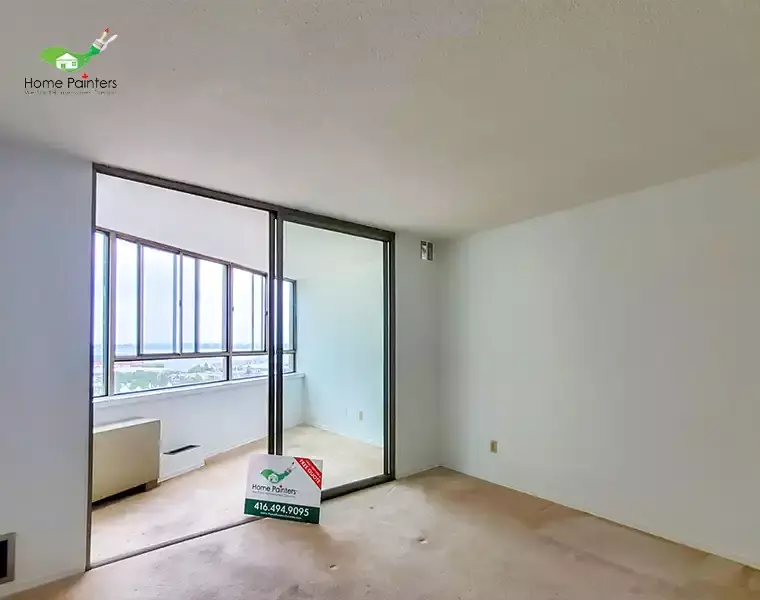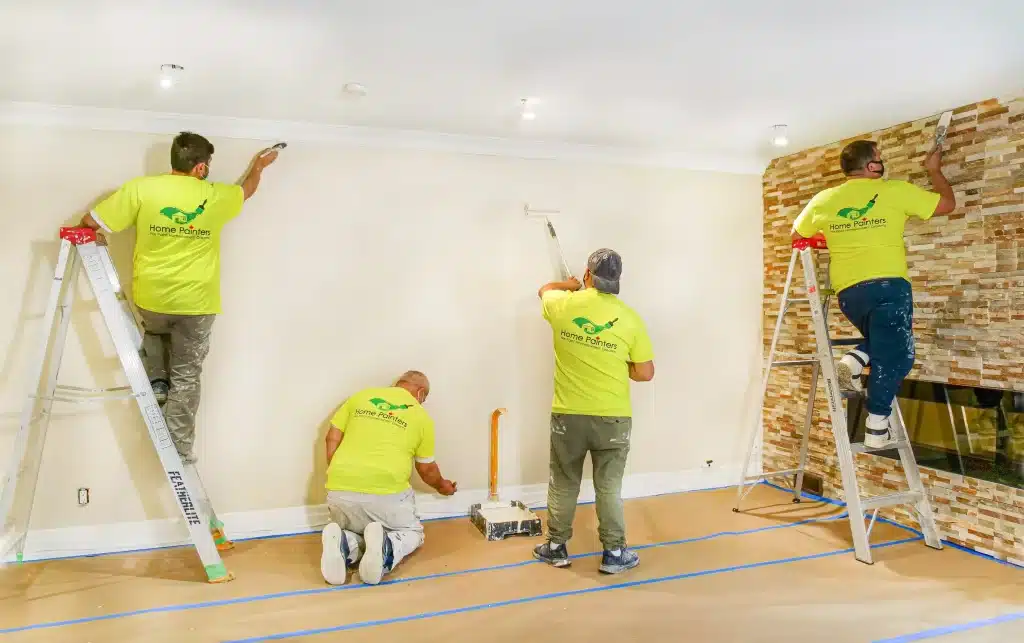
Painting your house can be fun, it will add character and invoke emotions. It is part of maintaining and protecting your walls, wood frames and metal inside your home. It will preserve your house for years to come.
When it comes to winter, this cold season seems to last forever. By the time spring comes around, you’re eager to tackle all the home projects for a fresh new look. Instead of waiting for spring to come, capitalize on the winter months by scheduling your interior painting projects. That way you can enjoy your new spaces while you’re cuddled up at home. And when spring arrives, you can enjoy other activities rather than waiting for home projects to be done.
Many people stay at home during winter because of the cold temperatures and snow days. Some companies need relatively warm and dry weather to do their job – construction workers, road workers, painters, concrete workers, etc. Of all the things to do in your home during the winter season you probably thought home improvement was out of the question. Well, that’s not entirely true.
What is the Best Weather Condition For Interior Painting?
The best time of day to paint a house interior is in winter. It improves the interior of your home. The dry and cool air inside your home during the winter months actually benefits the newly applied paint. Paint applied indoors should be at the right temperature. That’s why many professionals recommend winter months for painting the inside of your home. For instance, you want the temperature of the air, the wall surface and the paint to be between 60-80 degrees Fahrenheit to achieve a beautiful even finish. So before the next snowstorm, pick up some painting materials to transform the inside of your home before spring.
Painting your house interior in Winter
Is it safe to paint indoors in winter? The short answer is Yes, it is safe to paint indoors in winter. However, you will want to make sure that your house is well-insulated and has good ventilation. This will help prevent moisture from penetrating the walls, which can cause mould growth or premature wear on your newly painted surfaces.
Winter in Toronto and the GTA can be one of the quieter times for interior house painting. Should you even be doing house painting in the winter though? Absolutely! Most people put off the home renovation and painting projects during the winter months. They think that the cold weather makes interior house painting a bad idea. But, it’s actually the ideal time with many advantages! Let’s dig into all of the reasons why you should do some interior painting this winter season.
Why Should You Paint in the Winter?
Reason #1: Paint Dries Faster in the Winter
Why Does Paint Dries Faster In The Winter
Paint actually dries quicker in the lower temperatures of the winter season. There is less humidity in the winter and combined with the closed windows and your heating system, drying times are actually faster.
Can you paint in the winter outside? Since overnight temperatures can often chill exterior walls even if the ambient temperature is over 35 degrees, the best time to paint a house exterior is in the late morning after the sun has warmed up the surface of the home and stop painting around midday to give the paint time to cure.
Does paint dry faster in low humidity? The perfect humidity level for painting, particularly outdoors, is between 40 and 50 percent relative humidity. Some moisture in the air is a good thing when you’re painting since you don’t want the paint to dry too fast and start to crack or peel. Afraid of toxic interior paint fumes by letting your paint dry during the winter? Not to worry! With today’s low to zero VOC paints, it eliminates concerns over being indoors with paint fumes.
Did you know that paint actually dries faster in the winter than in summer? Humidity is to blame for a longer drying process in summer, but the crisp, cold winter air is your friend for winter painting projects. You can open windows to not only let the fumes out but to take full advantage of winter’s low humidity. It’s best to use low-to-zero VOC paints for health and safety precautions.
Painting in the winter fumes
When you paint using regular latex/acrylic paints, there is some odour, though the fumes have not been associated with any medical trouble or conditions.
Does acrylic paint dry faster in the sun? Acrylics are water-based. Their drying process has to do with the evaporation process of agents such as water. That is why acrylic paint dries faster in the sun.
What dries paint faster? Heat or Cold?
To dry properly, paint uses four components;
- Additives
- Binder
- Filler
- Solvent
The effectiveness of all four will depend on the temperature at which the wet paint is applied to the surface.
- Understanding whether heat or cold causes paint to dry faster will help you make the best-informed decision about when to paint exteriors
- Paint should be mixed with latex or acrylic when temperatures increase to -50 or -10 C. As the paint becomes thicker when painting at lower temperatures, it can become more porous. Due to its thicker layer, the paint is harder to dry. In cooler temperatures, oil-based paints will oxidize more slowly.
- • Using oil or latex paints in damp rooms, as well as paints based on water, is slower for drying when the weather is cold. Also, recoat times are extended because of this. Re-coats can usually be applied within four hours, once they have reached a temperature of 75 degrees or higher.
Paint Drying Temperature Celsius
The temperature of your house affects the performance of the paint. The wall temperature can vary from the weather temperature and must be above 10°C and below 35°C throughout the painting process. You should generally avoid painting in extremely hot or cold conditions.
Reason #2: More Time to Enjoy Your Interior Painting
Most people spend more time inside during the winter. Since it’s colder outside, there’s often less to do. This gives you a better opportunity to actually enjoy your new interior painting. Also, the other advantage of being inside a lot is you will find any imperfections and highlight details that need fixing so you can get the most out of your new paint.
Can You Paint Inside During Winter
As long as the humidity, temperature, and ventilation are right, you can paint safely in any room during any season. Choosing paint with fewer harmful chemicals is beneficial, especially when you may not want to leave the windows open to the elements.
While chillier months are perfect to settle into your home and feel cozy, these are actually the best times to start your home renovation projects. In fact, there are numerous benefits to painting your home’s interior in the winter months.
The ideal temperature and humidity for interior painting also an ideal temperature for painting inside a garage should be completed when relative humidity is between 40-50%. While too much humidity is damaging to paint, you still want some to reach a well-calibrated drying time. Avoid painting when the humidity is 85% or more.
When Is It too Cold to Paint Inside
Paint should never be applied at under 50 degrees and ideally not under 60. Take into account the temp of the walls, which in winter can be colder than the room air temp.

Reason #3: Lower Interior Painting Costs
The biggest advantage that most people don’t realize is that house painting in winter gives you a great opportunity to save time and money!
Since winter is a slow season for painters, you can capitalize on that to get a better rate. Not only may you have to wait weeks, if not months, if you decide to paint in spring or summer, but since there’s less demand for painters in winter, you can benefit from cost savings.
Not only can you benefit from off-season discounts, but you’ll find more time for any external projects you’ve been waiting for when spring and summer hit. Another great cost-saving for winter paint jobs? Choosing the best paints at a discounted price.
Many professional painters in Toronto and the GTA offer lower rates for painting your house during the slow winter season and that gives you the advantage of getting the same professional painting job at a more attractive price. It depends on the painting company and their pricing, but you can usually save anywhere from 10 – 30% off the regular price for interior painting during the winter months! That’s great savings which you can put towards something fun.

Reason #4: Shorter Lead Times & Fast Turnaround
With most people painting their houses during the warmer seasons, the best and most reputable professional painters will book up fast leading to longer wait times for painting your house. Booking during the slow season of winter for painting your house interior gives you shorter lead times and a better chance for a quick turnaround.
Reason #5: More Time for Summer Fun!
- Those summer months are super valuable to families. It’s often the only time of year that you have to relax, unwind and go on vacation. Planning ahead and getting your interior painting done in the winter, will free up your valuable summer vacation time for the things you enjoy most.
More Interesting Blogs Related to
“THE ADVANTAGES OF PAINTING YOUR HOUSE IN THE WINTER”
Don’t forget to check out our Pinterest page for all sorts of inspiration for an interior painting!
If you reside in Toronto and the GTA and need some help figuring out the painting costs per square foot, don’t hesitate to call us! We will help you pick the colours you want and show you the latest painting and home renovation trends. Our home painting services with the best pro painters have been around now for over 36 years.
Call 416.494.9095 or email [email protected] for a FREE quote for your home painting needs. And don’t forget to check us out on our social media channels below!





